GCP PostgreSQL | Entitle
What is GCP PostgreSQL?
Google Cloud Platform (GCP) PostgreSQL is a managed relational database service built on the open-source PostgreSQL engine. It allows users to deploy scalable, secure databases without managing the underlying infrastructure. The service includes built-in support for high availability, automated backups, replication, point-in-time recovery, and encryption.
How is this integration useful?
Integrating GCP PostgreSQL with Entitle helps eliminate manual provisioning of database roles and credentials, reduces the risk of over-permissioned accounts, and ensures that access to sensitive data is granted only when needed and only to authorized users. With auditability and policy enforcement built in, teams can maintain least-privilege access across GCP PostgreSQL environments while improving operational efficiency and compliance posture.
With this integration, Entitle can manage the following resource types in GCP Postgres SQL:
- Databases
- Schemas
- Servers
- Tables
End-user experience
-
Upon receiving a JIT (Just-In-Time) access using Entitle, the employee will receive a pre-made command for accessing GCP PostgreSQL via Teams/Slack.
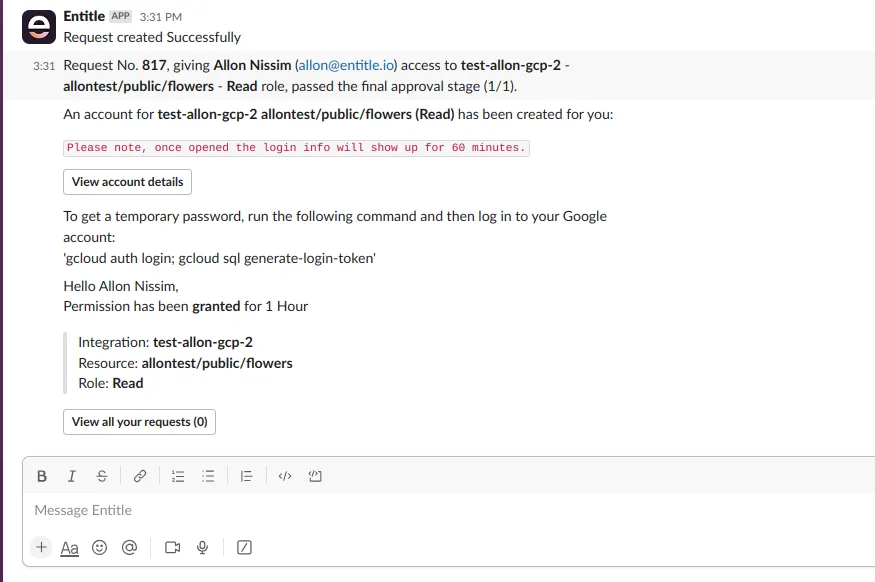
-
The employee will log in to GCP and create a login password with the following command:
gcloud auth login; gcloud sql generate-login-token -
The employee will connect to PostgreSQL by following the instructions given in the Connect using the Cloud SQL Auth Proxy Google Cloud guide.
Prerequisites
- Make sure you have Entitle's agent installed before proceeding with this guide.
For further details, see Entitle's agent guide.
- You need a Google organization owner account.
- Access to your GCP PostgreSQL service account in GCP, as well as service account keys in both GCP and Postgres.
Create a service account in GCP
If you're using an existing service account, proceed to step 5 in the following section.
-
Navigate to the GCP instance console. Make sure the project you wish to create a service account for is the appropriate one.
-
In the search bar, search for Service Accounts and select it from the results.

-
On the Service Accounts screen, click Create Service Account.

-
In the Service account details: Choose a service account ID or otherwise choose a name of your choice, and this field will be filled in automatically. Click Create and continue.
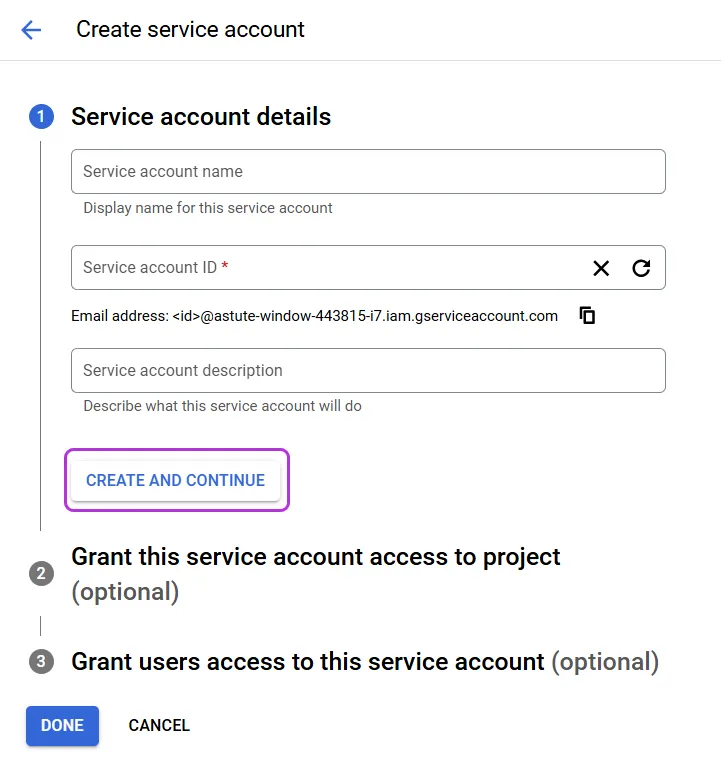
-
In Grant this service account access to project, search for the following roles in the list and add them one after another:
-
Cloud SQL Admin
-
Project IAM Admin
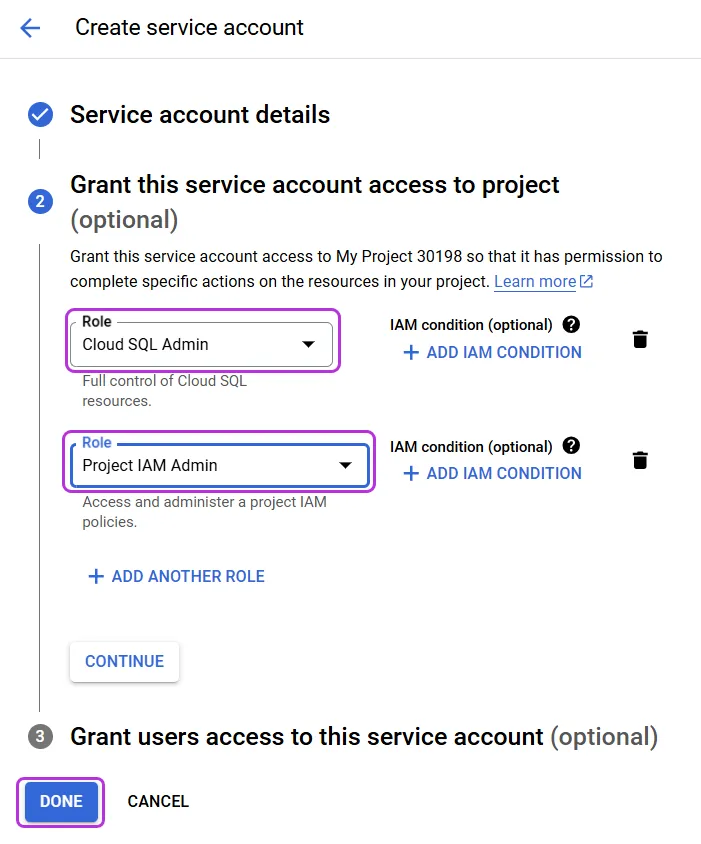
-
-
Click Done to create a new service account or save an existing one.
Create a key for the service account in GCP
-
Navigate to the Service Accounts screen in the GCP instance console.
-
Click on your newly created service account email.
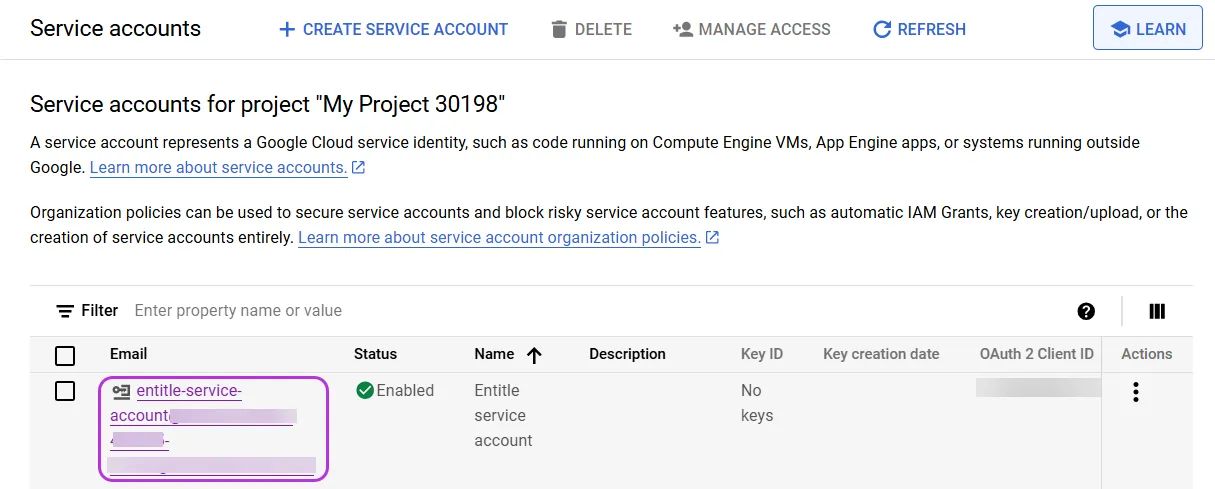
-
Click Keys > Add key > Create new key.
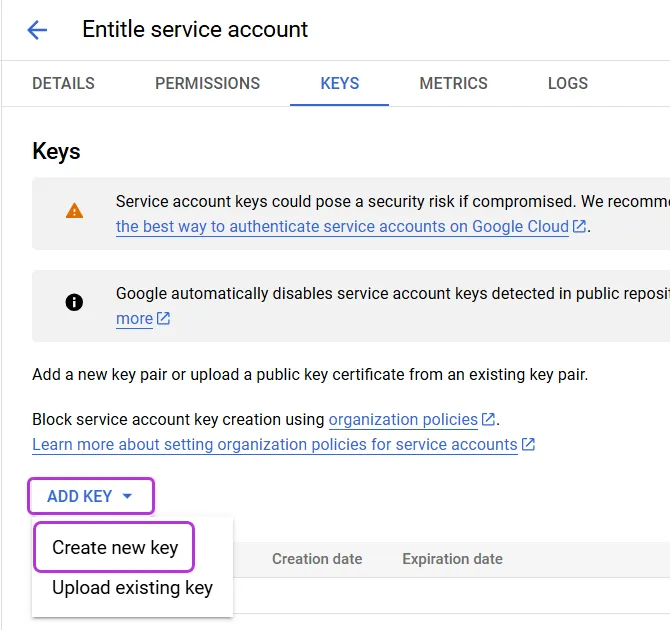
-
In the new pop-up window, choose JSON from the key type options and click Create. The key will download to your computer.
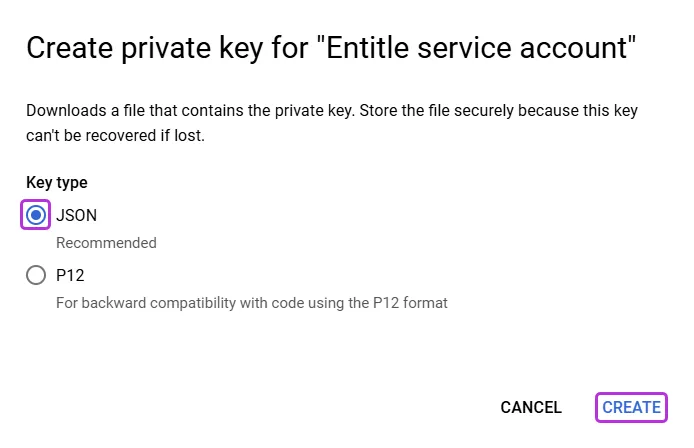
Configure domain-wide delegation
Your service account needs to have domain-wide delegation on certain scopes.
-
Go to the Manage Domain-Wide Delegation page
-
Click Add new.

-
In the Client ID field, enter the 21-digit number obtained from the key JSON file under the
client_idfield. -
In the OAuth scopes field, enter the following scopes:
https://www.googleapis.com/auth/admin.directory.user.readonly, https://www.googleapis.com/auth/admin.directory.group.readonly
Create a service account in Postgres
- Connect to any database (users are cluster-general) using the GCP console or any other Postgres client. If you're using the GCP console, run:
gcloud sql connect <database-name> --user=postgres --quiet - Run the following query on your Postgres cluster, after you have replaced the following fields with your credentials:
service_account_entitle: You may leave it or replace it as you wish.PASSWORD: Your password (appears once in the query).
CREATE ROLE service_account_entitle WITH LOGIN CREATEROLE INHERIT CONNECTION LIMIT -1 PASSWORD '<PASSWORD>';
GRANT "cloudsqlsuperuser" TO service_account_entitle;
Create the integration in Entitle
- Log in to Entitle and go to the Integrations page.
- Click Add Integration.
- In the Application field, enter GCP Postgres.
- In the Save on dropdown, select Save on cloud or your hosted agent.
- In the Connection section:
- In your GCP instance console Cloud overview > Project info, locate:
- The project ID: Insert it in the
project idfield - The project (instance) name: Insert it in the
instance_namefield - The region: Insert it in the
regionfield
- The project ID: Insert it in the
- In the
userandpasswordfields, insert the username and the password you created in the Create a service account in Postgres step. - Optional: in the
optionsfield, you can add the database names you wish to connect to. If you wish to connect to all databases, leave it empty. - In the
gcp_configfield, insert thegcp_configpart of the Service Account key created in the Create a key for the service account in GCP step.Example connection JSON
{ "project_id": "<project id found in the instance console overview>", "instance_name": "<instance name found in the instance console overview>", "region": "<region name found in the instance console overview>", "postgres_config": { "user": "<username>", "password": "<users password>", "options": { "databases_constraints": ["<To connect to specific databases, list their names. To connect to all, leave it empty.>"] } }, "gcp_config": { "credential_subject": "<an email of an admin in your organization which has permission to view all users and groups>", "service_account_key": { "type": "<found in service account key json>", "project_id": "<found in service account key json>", "private_key_id": "<found in service account key json>", "private_key": "<found in service account key json>", "client_email": "<found in service account key json>", "client_id": "<found in service account key json>", "auth_uri": "<found in service account key json>", "token_uri": "<found in service account key json>", "auth_provider_x509_cert_url": "<found in service account key json>", "client_x509_cert_url": "<found in service account key json>" } } }
- In your GCP instance console Cloud overview > Project info, locate:
- Click Save.
What's next?
Make sure your setup is complete by testing your integration.
Updated about 1 month ago
